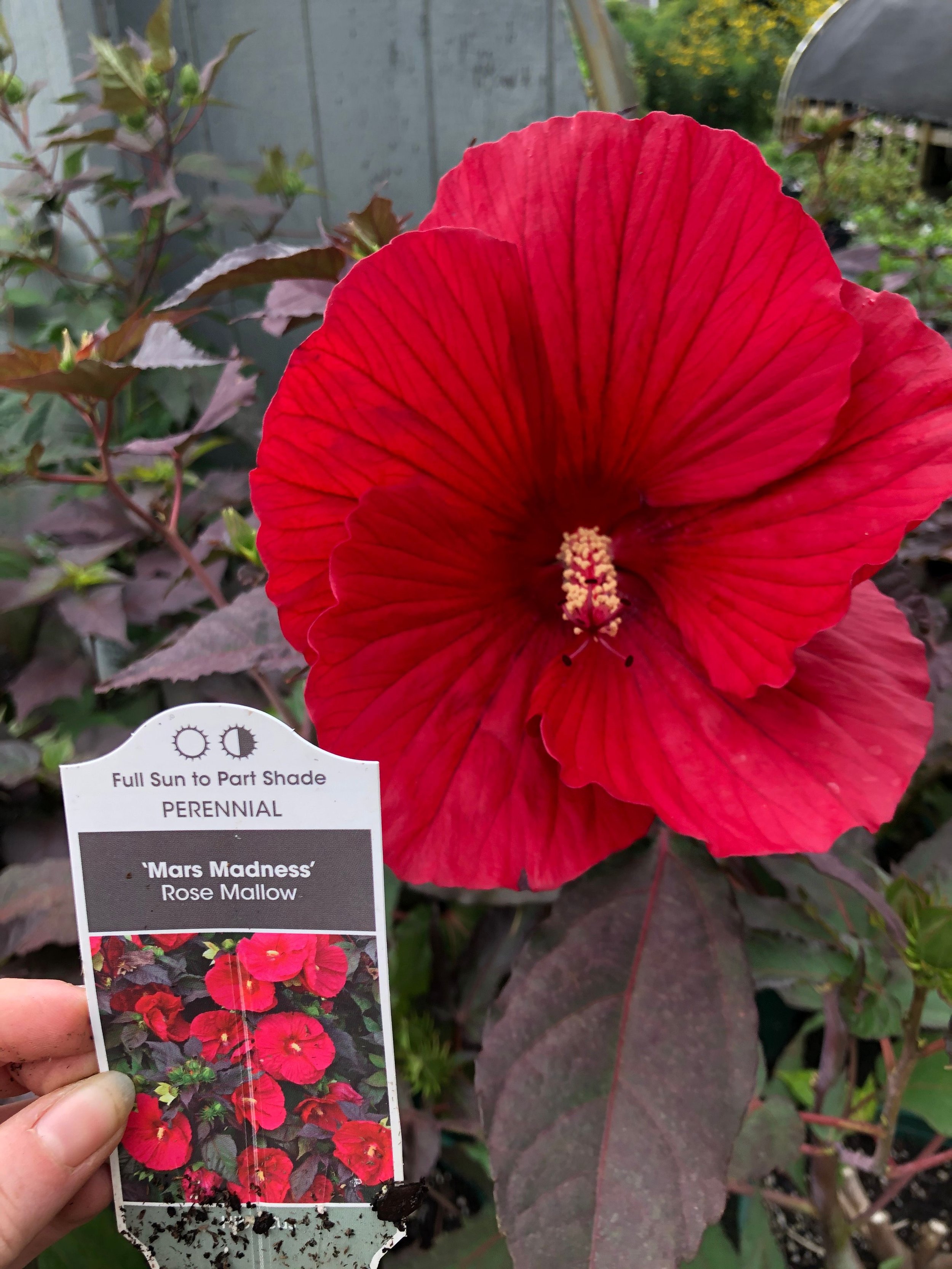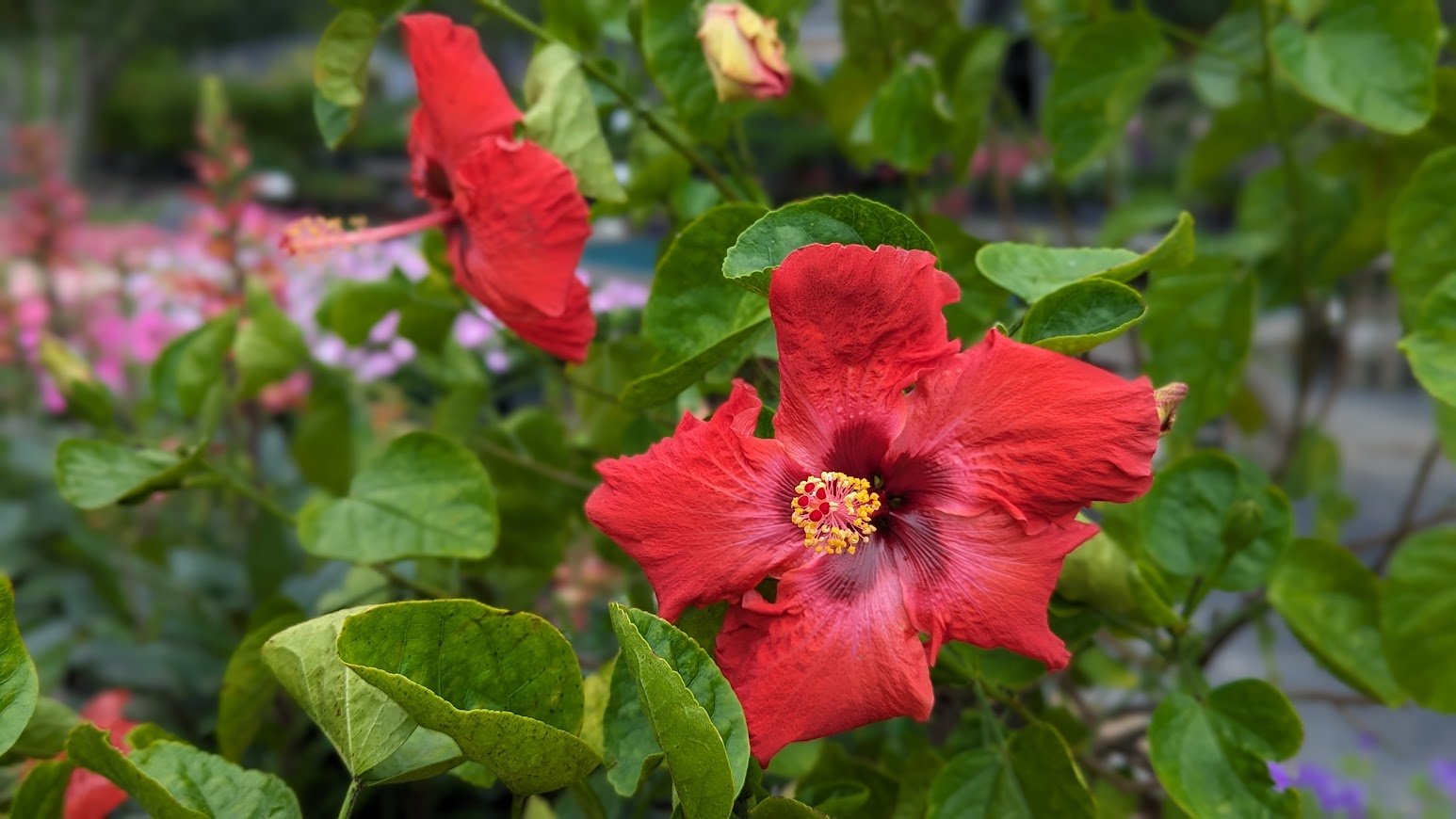HIBISCUS
Hibiscus plants add a bold, tropical effect to the garden with their huge, dinner-plate colorful flowers.
There are over 100 species of Hibiscus in the family Malvacea. They are mostly found in tropical areas but a few are hardier and will overwinter in our climate. Due to their tropical nature they are later to emerge and most bloom in mid to late summer. We grow both annual, perennial and shrubs in the hibiscus family. We carry other popular ornamental perennial plants in the Malva family that have similar flowers to Hibiscus, such as Hollyhocks (Alcea)and Sidalcea.
Jazzy Jewel Ruby Hibiscus (Tropical Hibiscus)
Hardy Hibiscus,
Shrub Hibiscus &
Tropical Hibiscus
*************************************
HARDY HIBISCUS
Hardy Hibiscus primarily includes the species native to North America such as Hibiscus moscheutos. These plants are true perennials, tend to have the largest flowers and die back to the ground each year. The species Hibiscus is known as Rose Mallow or Swamp Mallow and is native to Martha’s Vineyard. They are highly valued for their beautiful flowers late in the season. The pink flowers grow around ponds on the south shore and bloom profusely in mid to late summer. At Vineyard Gardens, we sell the species, as well as many hybrids with a wide range of flower colors (pink, purple, white, red & bi-color), large flower sizes and green to deep dark foliage. These perennials die to the ground in winter and emerge from the crown of the plant the following season.
____________________
CARE OF HARDY HIBISCUS
Hardy hibiscus needs frequent watering, especially when young and new. When watering, do so deeply and thoroughly, drenching the plant.
Mulch around the plant to retain moisture and to provide winter protection for the roots.
To encourage rebloom, either remove the spent flowers before they form seed heads or prune plants back by one-third after a flush of bloom is finished.
Perennial hibiscus will freeze back to the ground each winter; cut old stems to the ground.
Hibiscus bloom on new wood (this year’s growth), so pruning is best done in the spring.
In early spring, remove dead stems from established plants and apply a balanced fertilizer.
Mature plants can be divided in the spring, not fall.
Plant them in full Sun.
Varieties available
______________
Hibiscus mosheutus
Kopper King
Perfect Storm
Berry Awesome
Holy Grail
Candy Crush
![Hibiscus 'Berry Awesome' [photo credit Walters Gardens, Inc]](https://images.squarespace-cdn.com/content/v1/581a4aee8419c21ac8e2a58f/1721184861844-DEORC3R0F76KLRQFY25J/Hibiscus+%27Berry+Awesome%27+PP27936+CPBR5647+0001+high+res_waltersgarden.jpg)
![Hibiscus 'Berry Awesome' [photo credit Walters Gardens, Inc]](https://images.squarespace-cdn.com/content/v1/581a4aee8419c21ac8e2a58f/1721184873731-T9TMW5MLVHJR7IHM3RZO/Hibiscus+%27Berry+Awesome%27+PP27936+CPBR5647+0002+high+res_waltersgarden.jpg)
![Hibiscus 'Candy Crush' [photo credit Walters Gardens, Inc]](https://images.squarespace-cdn.com/content/v1/581a4aee8419c21ac8e2a58f/1721184873328-XDJQOX1NMIOCNLIL52Q6/Hibiscus+%27Candy+Crush%27+PP32587+CPBRAF+0000+high+res-waltersgarden.jpg)
![Hibiscus 'Dark Mystery' [photo credit Walters Gardens, Inc]](https://images.squarespace-cdn.com/content/v1/581a4aee8419c21ac8e2a58f/1721184875920-V9A6T09VI7TWQOHKPYNS/Hibiscus+%27Dark+Mystery%27+PP32036+0001+high+res.jpg)
![Hibiscus 'Holy Grail' [photo credit Walters Gardens, Inc]](https://images.squarespace-cdn.com/content/v1/581a4aee8419c21ac8e2a58f/1721184884774-AMGUI6E09XHJNL95I3OC/Hibiscus+%27Holy+Grail%27+PP31478+CPBRAF+0005+high+res.jpg)
![Hibiscus 'Marshmallow Moon' [photo credit Walters Gardens, Inc]](https://images.squarespace-cdn.com/content/v1/581a4aee8419c21ac8e2a58f/1721184881911-H4SMV7QWEE6DZATXPBBK/Hibiscus+%27Marshmallow+Moon%27+PP35990+0001+high+res.jpg)
![Hibiscus 'Midnight Marvel' [photo credit Walters Gardens, Inc]](https://images.squarespace-cdn.com/content/v1/581a4aee8419c21ac8e2a58f/1721184884818-SL37C4I1W1F8OW2KI013/Hibiscus+%27Midnight+Marvel%27+PP24079+0001+high+res.jpg)
![Hibiscus 'Perfect Storm' [photo credit Walters Gardens, Inc]](https://images.squarespace-cdn.com/content/v1/581a4aee8419c21ac8e2a58f/1721184888055-55KI3BZMLO5FXZKYFJBX/Hibiscus+%27Perfect+Storm%27+PP27880+CPBR5648+0003+high+res.jpg)

[1. Hibiscus ‘Berry Awesome 2. Hibiscus ‘Berry Awesome 3. Hibiscus ‘Candy Crush’ 4. Hibiscus ‘Dark Mystery’ 5. Hibiscus ‘ Holy Grail’ 6. Hibiscus Marshmallow Moon’ 7. Hibiscus ‘Midnight Marvel’ 8. Hibiscus ‘Perfect Storm’ 9. Rose Mallow ‘Mars Madness’ . All photos above credit to Walters Gardens, Inc]
Midnight Marvel
Dark Mystery
Marshmallow Moon
(LUNA SERIES)
Luna Red
Luna White
(DISCO BELL SERIES)
Pink
*************************************
SHRUB HIBISCUS
The most popular shrub is the Rose of Sharon also known as Hibiscus Syriacus. Rose of Sharon has a woody habit and bloom on the same structure each year. It has beautiful hibiscus like flowers in mid to late summer and is valued as an ornamental in landscapes. These tend to be the largest in size with some varieties getting 15′ tall.
____________________
CARE OF ROSE OF SHARON
Full Sun woody shrub
A little late to emerge in spring because of its tropical roots
Blooms on new growth, therefore best pruned in spring when buds start to swell and plant comes to life
Prune out a few of the biggest oldest stems as low as possible. Encourage young stems as these will produce the most flowers, and growth from down low in the shrub. That helps keep it looking full. Rose of Sharon grow from the tips so they can lack growth down low if not pruned properly.
Fertilize new plantings with a slow release complete fertilize
Rose of Sharon
Varieties available
____________
HIBISCUS SYRIACA
(ROSE OF SHARON)
(Single Flowers)
Diana
Aphrodite
Fiji
Red Heart
Minerva
Blue Satin
(Double Flowers)
Chiffon Blue
Chiffon Lavender
Chiffon Pink
Hibiscus syriacus
*************************************
TROPICAL HIBISCUS
The annual hibiscus we carry is the tropical hibiscus also known as Hibiscus rosa sinensis. Hibiscus rosa-sinensis, are from southeast Asia and are technically a shrub but less hardy than Rose of Sharon. This plant makes a lovely garden or container plant and will bloom all summer long. We usually carry it in both shrub form and as a topiary patio tree. The tropical hibiscus is not frost tolerant.
Hibiscus Tropical Jewel Ruby
Varieties available
______________
HIBISCUS TROPICAL
The Path
Cherie
Hula Girl
Red Dragon
***
Jazzy Jewel Series
Opal
Ruby
Amber
Gold
Hibiscus Too Hot To Handle
Hibiscus illustration karen blackerby logan
____________________
GROWING CONDITIONS
Prefer full sun. They will grow in partial sun but will not flower as well.
Prefer well-draining soil with plenty of organic matter, and neutral to slightly acidic soil.
To avoid breakage of the long stems, plant hibiscus where they won’t be exposed to strong winds.
____________________
Hibiscus Brilliant (Tropical Hibiscus)
Hibiscus Hula Girl (Hibiscus Tropical)
*************************************









